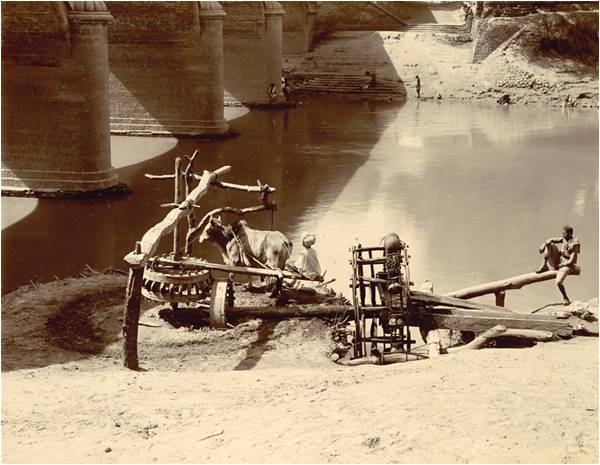
A photograph of a bullock-driven water wheel at the Fuleli Canal in Sindh taken by an unknown photographer in the 1890s. The Persian water wheel is a traditional water-lifting device in South Asia.
Water wheels were invented in ancient Egypt and Persia as an improvement on well irrigation, to increase the acreage of land irrigated. In its oldest and simplest form the water wheel (saqiya or noria) consists of a number of earthen pots attached to ropes or chains and suspended round a huge wooden wheel. This wheel is at one end of a horizontal wooden axle and is connected to a small wheel at the other end. The horizontal axle is usually embedded in the ground or under a platform so that it does not impede the movement of draft animals. Another large wheel is mounted on a vertical axle to which is attached a long shaft. This wheel can be turned by camels, donkeys, bullocks or oxen by means of the shaft.
As it turns, the small wheel on the horizontal axle is driven like a gear and in turn causes the huge wheel to rotate. Water is lifted by the pots on this wheel and transferred into a channel for irrigation.
This photograph is from an album of 91 prints apparently compiled by PJ Corbett, an engineer involved in irrigation work at the famine relief camp at Shetpal Tank in 1897, and in canal construction in Sindh in the early 1900s.
Water wheels were invented in ancient Egypt and Persia as an improvement on well irrigation, to increase the acreage of land irrigated. In its oldest and simplest form the water wheel (saqiya or noria) consists of a number of earthen pots attached to ropes or chains and suspended round a huge wooden wheel. This wheel is at one end of a horizontal wooden axle and is connected to a small wheel at the other end. The horizontal axle is usually embedded in the ground or under a platform so that it does not impede the movement of draft animals. Another large wheel is mounted on a vertical axle to which is attached a long shaft. This wheel can be turned by camels, donkeys, bullocks or oxen by means of the shaft.
As it turns, the small wheel on the horizontal axle is driven like a gear and in turn causes the huge wheel to rotate. Water is lifted by the pots on this wheel and transferred into a channel for irrigation.
This photograph is from an album of 91 prints apparently compiled by PJ Corbett, an engineer involved in irrigation work at the famine relief camp at Shetpal Tank in 1897, and in canal construction in Sindh in the early 1900s.
–B ritish Library: Asia, Pacific and Africa Collections

